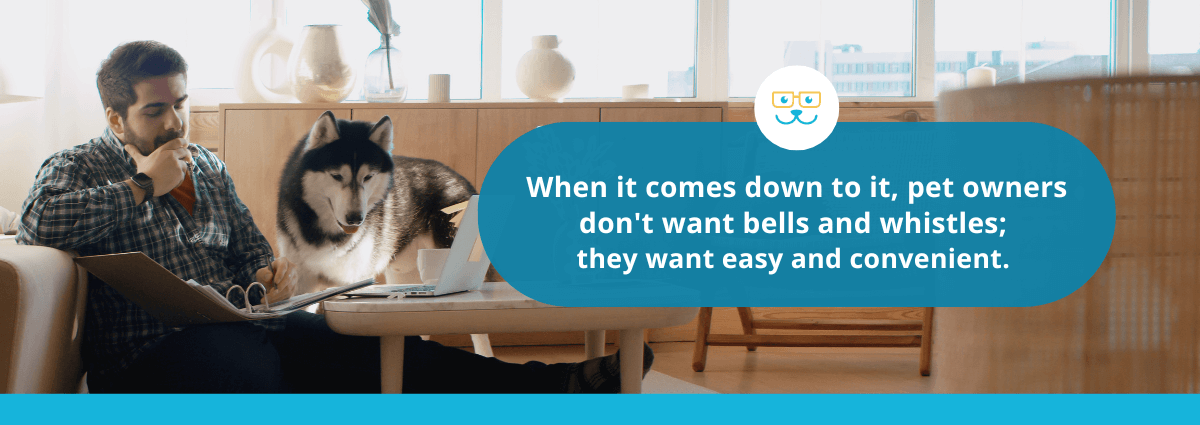What Pet Owners Really Want From Your Veterinary Website
When a pet parent lands on your veterinary website, they're not just browsing; they're looking for reassurance. They want to know: Can I trust these people with my four-legged family member? Your website is often the first and most important chance you'll get to answer questions pet parents have.

A high-performing veterinary website doesn't just share your hours and phone number; it creates an experience that helps pet owners feel understood, supported, and confident enough to book an appointment.
It's time to take a peek behind the stats to understand precisely what pet parents are looking for when using your website. Here's what your website needs to do to engage and convert them:
A Mobile-First, Responsive Design
Pet owners aren't just searching from their laptops. They're Googling your clinic while juggling a leash, a toddler, or an anxious pet in the back seat. In fact, the majority of local veterinary searches happen on mobile devices.
That's why a truly mobile-friendly website isn't just a shrunken version of your desktop site. Responsive design means your website automatically adapts to every screen size, stacking menus, resizing images, and reformatting layouts for a seamless experience.
And the best websites go a step further: they're designed mobile-first, prioritizing the phone experience before scaling up to tablets and desktops. Because if your website doesn't load quickly, look polished, and function flawlessly on a phone, you're losing potential clients before they ever call.
A Clear, Trust-Building Path
Our analytics show that pet owners follow a predictable journey when they visit your website:
- Homepage First Impressions: They want a welcoming, professional look that reflects your level of care. The homepage should load quickly, showcase your clinic's personality, and offer clear next steps.
- Meet the Team: This is the #1 section visitors head to after your homepage. Pet owners want to see who will care for their pets. They want to see faces, credentials, and a personal touch, such as a favorite pet or hobby, which builds an instant connection.
- Services Page: Next, they check if you offer what their pet needs, whether it's vaccinations, dental care, surgery, or urgent services.
- Testimonials & Reviews: Before trusting anyone with their pet, they want to hear from others who have had similar experiences. Positive, recent reviews reassure visitors and help them feel confident in choosing your clinic.
- Educational Content: Blogs, FAQs, or resources demonstrate that you're committed to pet health beyond appointments. If they're reading your blog, they're moving from "shopping around" to "seriously considering" your practice.
Importantly, this decision-making process almost always spans multiple visits. Rarely do pet owners book on their first click; they come back several times before reaching out.
A Simple, Fast-Loading Homepage
One of the biggest mistakes we see is what we call "homepage overload." Out of enthusiasm, many practices cram videos, dozens of photos, every service, testimonials, staff bios, and more onto their homepage. But in our instant-gratification world, if your homepage takes too long to load, especially on a phone, pet owners will leave before they ever see your message.

Our data shows that the most successful veterinary websites have clean, streamlined homepages that make a fast first impression and guide visitors deeper into your site. Think of it like your clinic's front door: it should feel inviting and convey a sense of your personality, but it doesn't need to display every single exam room at once.
GeniusTip: Photos on your homepage should always be updated and relevant. If you paint your walls, don’t forget to update your photos. You won’t want a client to think they walked into the wrong practice.
Content That Connects and Educates
Beyond flashy graphics, what pet parents truly want is content that speaks directly to their concerns. They want to see that you understand common pet problems, can offer solutions, and will treat their pets like family. Regularly updated blogs and resources demonstrate your activity, knowledge, and commitment to pet health.
And remember: pet owners often read your blog posts to confirm that you're up-to-date on modern veterinary care. Each new piece of content builds your credibility and moves them closer to trusting you with their pet's well-being.
Genius Tip: If you're unsure what to write about, ask your front desk staff about the most common questions they receive, and then turn those into blog posts. If you're looking to expand on content beyond those common questions, then you need the GeniusVets Content Libraries.
Tap Into The Content Libraries
Consistent, Accurate Information
Pet owners get frustrated fast when they find inconsistent info about your hours, address, or phone number across your website, Google Business Profile, and directories like Yelp. Consistency is key to building trust and ensuring you can be reached when it matters most.
Give Pet Parents What They're Looking For

When it comes down to it, pet owners don't want bells and whistles; they want easy and convenient. They're looking for a veterinary website that loads quickly on any device, clearly showcases who you are, explains what you offer, and helps them feel at ease about trusting you with their furry family member.
A clean, mobile-first design, easy navigation, updated educational content, consistent information, and genuine team bios aren't just nice-to-haves; they're the keys to transforming casual visitors into loyal clients.
By building your website around what pet parents truly want, you're not just creating a pretty online presence; you're laying the foundation for relationships that last a lifetime.
Ready to ensure your website provides pet owners with everything they're looking for? Let's turn your site into the most powerful tool in your practice. Book your free Marketing Health Exam today.
Book Your Complimentary Marketing Health Exam
Want more tips like this every week?
Subscribe to the GeniusVets Weekly Newsletter and get fresh insights, free resources, and veterinary marketing strategies delivered straight to your inbox.

